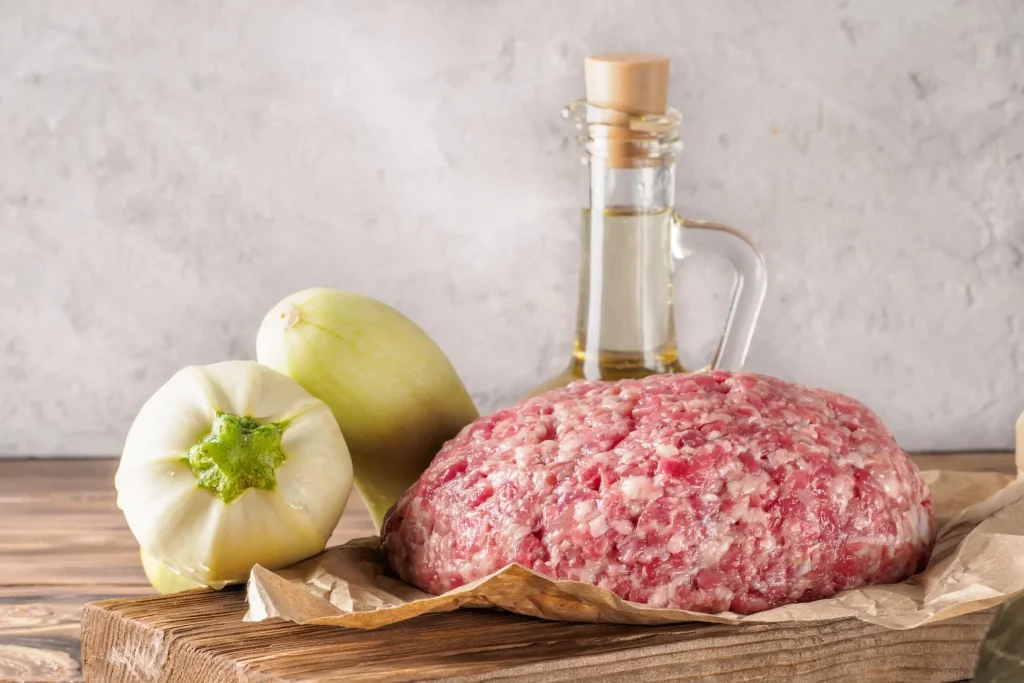The Best Fluffy Pancakes recipe you will fall in love with. Full of tips and tricks to help you make the best pancakes.
If you’re a fan of bold, savory flavors, homemade peppercorn sausages are a must-try. These juicy, spice-infused sausages offer the perfect balance of heat and richness, making them a standout dish for any meal. Whether you’re grilling them for a backyard BBQ, pan-frying them for breakfast, or adding them to a hearty pasta dish, their robust taste is sure to impress.
Making your own sausages at home allows you to control the ingredients, ensuring a fresh and flavorful result without unwanted preservatives or fillers. Plus, the process is easier than you might think! With just a few simple ingredients and the right techniques, you can create restaurant-quality sausages right in your kitchen.
In this guide, we’ll walk you through everything you need to know—from the essential ingredients and equipment to step-by-step instructions and expert tips for achieving the perfect juicy texture. Get ready to elevate your homemade sausage game with this delicious peppercorn-infused recipe!
Why You Should Make Homemade Peppercorn Sausages
Making your own peppercorn sausages at home might seem like a challenge, but once you try it, you’ll never go back to store-bought versions! Not only do homemade sausages offer superior taste and quality, but they also allow you to control every ingredient, ensuring a healthier and more flavorful final product. Here’s why making homemade peppercorn sausages is worth the effort:

1. Better Flavor Control
One of the biggest advantages of making your own sausages is the ability to customize the flavor exactly to your liking. Store-bought sausages often contain generic spice blends, but when you make them at home, you can adjust the seasoning levels, experiment with different types of peppercorns (black, white, or pink), and add complementary spices like garlic, smoked paprika, or fennel. Whether you prefer a mild heat or a bold, peppery kick, homemade sausages give you complete control over taste.
2. Healthier Alternative to Store-Bought Sausages
Many pre-packaged sausages contain preservatives, artificial flavorings, and excessive amounts of salt and fat. By making your own, you can ensure that only high-quality ingredients go into your sausages. You can also choose leaner cuts of meat, use natural casings, and avoid unhealthy additives. Plus, homemade sausages allow you to monitor sodium levels and use fresh, organic spices for a cleaner, healthier meal.
3. Cost-Effective and Budget-Friendly
Buying high-quality sausages from specialty stores or butcher shops can be expensive, especially when looking for gourmet flavors like peppercorn. When you make your own, you get more value for your money. Bulk-purchasing meat and spices can help you save costs, and you can make large batches to store for later use. Plus, if you’re already into home cooking, investing in a meat grinder and sausage stuffer can be a cost-effective long-term choice.
4. A Fun and Rewarding DIY Cooking Project
Making sausages at home isn’t just about the end result—it’s also a fun and rewarding experience. If you enjoy hands-on cooking projects, learning how to grind, season, and stuff sausages can be a great way to expand your culinary skills. It’s also a fantastic activity to do with family or friends, making the cooking process more enjoyable. Once you master the technique, you’ll have the freedom to create endless sausage variations, experimenting with different spices, meats, and fillings.
Essential Ingredients and Equipment for Peppercorn Sausages
Before you start making homemade peppercorn sausages, it’s important to gather all the necessary ingredients and equipment. Having the right tools and high-quality ingredients will ensure that your sausages turn out flavorful, juicy, and perfectly textured.
Key Ingredients for Homemade Peppercorn Sausages
The secret to delicious homemade sausages lies in using fresh ingredients and the right balance of spices. Here’s what you’ll need:
1. Meat Selection
The choice of meat is crucial for achieving the right texture and flavor in your sausages. The most common options include:
- Pork: The traditional choice for sausages, offering a great balance of fat and flavor. Look for pork shoulder or pork butt, which have a good fat-to-lean ratio (about 70% lean, 30% fat).
- Beef: Provides a rich and bold taste, especially when mixed with pork or other meats.
- Chicken or Turkey: Leaner options for those looking for a healthier alternative, though you may need to add some fat (such as olive oil or pork fat) to maintain juiciness.
- Lamb: A unique choice that pairs well with black pepper and other spices, giving the sausages a deep, savory flavor.
2. Black Peppercorns (Star Ingredient)
Peppercorns are what set these sausages apart! You can use different varieties to customize the spice level and depth of flavor:
- Black Peppercorns: The most common choice, offering a bold, slightly spicy taste.
- White Peppercorns: Milder in heat but with an earthy, slightly fermented flavor.
- Green Peppercorns: Less pungent and fresher in taste, ideal for a more subtle peppery kick.
- Crushed or Whole: Using freshly crushed peppercorns ensures maximum flavor, but you can also grind them finely for a more even distribution.
3. Additional Seasonings and Spices
- Garlic (Fresh or Powdered): Adds depth and aroma.
- Salt: Enhances all the flavors—use sea salt or kosher salt for the best taste.
- Paprika: Offers a mild smokiness and vibrant color.
- Fennel Seeds: A classic sausage spice that complements the peppery notes.
- Cayenne Pepper or Chili Flakes (Optional): For those who love extra heat.
4. Sausage Casings
- Natural Casings (Pork or Sheep Intestines): Traditional choice that provides the best texture and bite.
- Collagen Casings: Easier to handle and more uniform in size, great for beginners.
- Skinless Option: If you don’t want to use casings, you can shape the mixture into sausage patties instead.
Essential Equipment for Sausage Making
Having the right tools will make the process smoother and more enjoyable. Here are the key pieces of equipment you’ll need:
1. Meat Grinder (Manual or Electric)
A meat grinder allows you to control the texture of the sausage. While you can buy pre-ground meat, grinding your own ensures better freshness and fat distribution. If using a manual grinder, expect a bit of elbow grease, but an electric grinder speeds up the process significantly.
2. Sausage Stuffer
This tool helps fill the sausage casings without air pockets. Some meat grinders come with sausage stuffing attachments, or you can use a dedicated sausage stuffer for more control. If you don’t have one, you can use a piping bag or funnel as a DIY alternative.
3. Sharp Knives and Cutting Board
You’ll need these for trimming meat and cutting sausage links to size. A sharp knife makes the process easier and more efficient.
4. Mixing Bowls and Measuring Spoons
Large mixing bowls help blend the meat and seasonings evenly. Measuring spoons ensure precise spice ratios, preventing overpowering flavors.
5. Food Scale
A food scale helps measure the right amount of meat and fat, ensuring consistency in texture and flavor. It’s especially useful if you’re making sausages in bulk.
6. Storage Bags or Vacuum Sealer (For Freezing)
If you’re making a big batch, airtight storage is key. Vacuum sealing keeps sausages fresh longer, but freezer bags work well if you plan to use them within a few weeks.
Step-by-Step Guide to Making Juicy Peppercorn Sausages
Making homemade peppercorn sausages may seem intimidating at first, but with the right technique, you’ll end up with sausages that are flavorful, juicy, and perfectly textured. Follow this step-by-step guide to create delicious sausages from scratch.

Step 1: Prepare Your Ingredients and Equipment
Before you begin, gather all your ingredients and ensure that your equipment is clean and ready to use. This will make the process smoother and more efficient.
- Chill your meat, fat, and grinder attachments in the freezer for about 30–45 minutes. Cold ingredients prevent smearing and ensure a better texture.
- Soak natural casings in warm water for at least 30 minutes to soften them. If using collagen casings, follow the package instructions.
- Set up your meat grinder and sausage stuffer, ensuring all parts are properly attached.
Step 2: Grind the Meat for the Perfect Texture
Grinding your own meat ensures better flavor, freshness, and texture. The ideal fat-to-lean ratio for sausages is about 70% lean meat to 30% fat for juicy results.
- Cut your chilled pork (or chosen meat) and fat into small chunks that fit into the grinder.
- Feed the meat and fat into the grinder, alternating pieces to ensure even distribution.
- Use a medium-coarse grinding plate for a good balance of texture and moisture. If you prefer a finer grind, pass the meat through the grinder a second time.
- Keep the ground meat cold by placing it in the fridge while preparing the seasoning.
Step 3: Season the Meat Mixture with Peppercorn and Spices
Now it’s time to infuse the sausage with bold, peppery flavors. Using freshly ground black peppercorns will give the sausages an aromatic and slightly spicy kick.
- In a large mixing bowl, combine the ground meat with:
- 2 tablespoons freshly crushed black peppercorns (adjust to taste)
- 1 tablespoon kosher salt (essential for bringing out flavors)
- 1 teaspoon smoked paprika (adds a touch of smokiness)
- 1 teaspoon garlic powder or minced garlic (for depth of flavor)
- 1 teaspoon fennel seeds (optional but complements the pepper well)
- ½ teaspoon cayenne or red pepper flakes (optional for extra heat)
- Mix thoroughly using your hands or a stand mixer fitted with a paddle attachment. The key is to mix until the meat becomes sticky and binds together (about 2–3 minutes).
- Cover the bowl and refrigerate the mixture for at least 1 hour or overnight to allow the flavors to develop.
Step 4: Stuff the Sausages into Casings
If using natural casings, rinse them thoroughly and slide them onto the sausage stuffer nozzle. Slowly feed the seasoned meat mixture into the stuffer while controlling the flow to avoid air pockets. Once the sausage reaches the desired length, twist the casing to form links. Repeat until all the mixture is used.
For skinless sausages, shape the meat into patties or logs and wrap them in plastic before refrigerating.
Step 5: Cook or Store Your Sausages
You can cook the sausages immediately or store them for later use.
- For immediate cooking: Grill, pan-fry, or bake at medium heat until the sausages are golden brown and fully cooked, reaching an internal temperature of 160°F (71°C).
- For storage: Place the sausages in an airtight container or vacuum-seal them before refrigerating for up to three days or freezing for up to three months.
Homemade peppercorn sausages offer a bold and savory flavor that’s perfect for breakfast, grilling, or adding to your favorite recipes. Once you master this process, you can experiment with different spice blends and meats to create your own signature sausage.
Vous avez dit :
please elaborate or expend on the H2 section titled : How to Cook and Serve Homemade Peppercorn Sausages
ChatGPT a dit :
How to Cook and Serve Homemade Peppercorn Sausages
Once you’ve prepared and stuffed your homemade peppercorn sausages, it’s time to cook them to perfection. Whether you prefer grilling, pan-frying, baking, or simmering, each method brings out different textures and flavors. After cooking, serving them with the right pairings will elevate your meal. Here’s how to cook and serve your homemade sausages for maximum flavor and enjoyment.

Cooking Methods for Homemade Peppercorn Sausages
Grilling for a Smoky, Charred Flavor
Grilling is an excellent way to enhance the natural flavors of the sausages while adding a smoky aroma and crispy exterior.
- Preheat the grill to medium heat (about 350°F or 175°C).
- Lightly oil the grill grates to prevent sticking.
- Place the sausages on the grill, ensuring they are not too close together for even cooking.
- Cook for 10 to 15 minutes, turning occasionally, until the sausages are evenly browned and reach an internal temperature of 160°F (71°C).
- Let the sausages rest for a few minutes before serving to retain their juiciness.
For a smokeless grilling experience with even cooking, you can use the Ninja GR101 Smokeless Grill, which provides perfect cooking with precise temperature control.
Pan-Frying for a Crispy and Juicy Bite
Pan-frying is a quick and effective way to achieve a crispy, caramelized exterior while keeping the sausages juicy inside.
- Heat a tablespoon of oil or butter in a large skillet over medium heat.
- Add the sausages and cook, turning occasionally, for 10 to 12 minutes until golden brown.
- If the sausages brown too quickly, reduce the heat slightly and cover the pan for a few minutes to ensure they cook through.
- Check that the internal temperature reaches 160°F (71°C) before removing from heat.
Baking for an Easy, Hands-Free Option
Baking is a convenient method that allows the sausages to cook evenly without requiring much attention.
- Preheat the oven to 375°F (190°C).
- Line a baking sheet with parchment paper or lightly grease it.
- Arrange the sausages on the sheet with space between them.
- Bake for 25 to 30 minutes, flipping halfway through, until the sausages are browned and fully cooked.
- For extra crispiness, broil for the last 2 to 3 minutes.
Simmering for a Tender and Juicy Texture
Simmering sausages before grilling or pan-frying can help keep them extra juicy and prevent them from bursting.
- Bring a pot of water or broth to a gentle simmer (not a rolling boil).
- Add the sausages and let them cook for 10 to 15 minutes.
- Finish by searing them in a pan or on the grill for a crispy exterior.
Best Ways to Serve Homemade Peppercorn Sausages
Classic Sausage Sandwiches or Rolls
- Serve grilled or pan-fried sausages in a toasted bun with mustard, caramelized onions, and sauerkraut.
- Add a spicy kick with jalapeños or hot sauce.
- Pair with a fresh salad or coleslaw for balance.
With Hearty Side Dishes
- Mashed potatoes and gravy complement the bold flavors of the peppercorn.
- Roasted vegetables like Brussels sprouts, bell peppers, and onions add a delicious contrast.
- Serve alongside rice or a grain salad for a wholesome meal.
As a Breakfast Protein
- Slice sausages and serve them with scrambled eggs, toast, and sautéed mushrooms.
- Pair with pancakes or waffles for a sweet and savory twist.
- Add them to a breakfast burrito with eggs, cheese, and avocado.
In Pasta, Soups, and Stews
- Slice sausages into pasta dishes with a creamy or tomato-based sauce.
- Add them to lentil soup or bean stew for extra depth of flavor.
- Use them in a hearty gumbo or jambalaya for a spicy Creole touch.
Homemade peppercorn sausages are incredibly versatile and can be enjoyed in countless ways. Whether grilled, pan-fried, baked, or simmered, they make a delicious addition to any meal. Experiment with different sides and serving ideas to find your perfect combination.
Common Mistakes to Avoid When Making Sausages
Making homemade peppercorn sausages is a rewarding process, but small mistakes can affect the flavor, texture, and overall quality of the sausages. Whether you’re a beginner or an experienced cook, avoiding these common pitfalls will help ensure your sausages turn out juicy, flavorful, and perfectly textured every time.
1. Using Meat That’s Too Lean
One of the most critical factors in making sausages is the meat-to-fat ratio. Using lean meat without enough fat results in dry and crumbly sausages.
- Solution: Aim for a 70% lean meat to 30% fat ratio for the best texture and juiciness. Pork shoulder is an excellent choice because it has the right balance of lean meat and fat. If using leaner meats like chicken or turkey, add pork fat or beef fat to compensate.
2. Not Keeping Everything Cold
Heat is the enemy when making sausages. If the meat, fat, or equipment gets too warm, the fat can smear, leading to a grainy texture and greasy sausages.
- Solution: Keep your meat, fat, and grinder parts chilled at all times. Place them in the freezer for 30–45 minutes before grinding to maintain a cold temperature. Also, work quickly and refrigerate the mixture if it starts to warm up.
3. Over- or Under-Mixing the Meat Mixture
Mixing is essential for achieving the right texture, but over-mixing can result in tough sausages, while under-mixing can cause the sausages to fall apart.
- Solution: Mix the seasoned ground meat just until it becomes slightly sticky and cohesive (about 2–3 minutes). If using a stand mixer, mix on low speed with a paddle attachment to prevent overworking the meat.
4. Not Seasoning the Meat Properly
Under-seasoned sausages will taste bland, while over-seasoning can make them too salty or overpowering.
- Solution: Follow a balanced spice ratio and always do a taste test before stuffing the sausages. Fry a small portion of the mixture in a pan and adjust the seasoning if needed. Freshly ground peppercorns, salt, garlic, and herbs should be well-distributed for even flavor.
5. Not Using the Right Type of Casings
Casings play a crucial role in sausage texture and cooking. If they are too dry, too thick, or improperly prepared, they can lead to tough, chewy, or burst sausages.
- Solution: Use natural casings for the best bite and flavor. Soak them in warm water for at least 30 minutes before stuffing to make them pliable. If using collagen casings, choose a type that matches your cooking method.
6. Stuffing Sausages Too Tightly or Too Loosely
If sausages are overstuffed, they may burst during cooking. If they are underfilled, they can have air pockets and an uneven texture.
- Solution: Stuff the sausages firmly but not overly tight to allow a little room for expansion when cooking. Prick small air bubbles with a sterilized pin to prevent them from bursting.
7. Grinding the Meat Incorrectly
The way you grind the meat affects the final texture of your sausages. Grinding meat that is too warm or using the wrong grinder plate can result in an unpleasant, mushy texture.
- Solution:
- Keep the meat cold before and after grinding.
- Use a medium-coarse grinder plate for a balanced texture.
- For a finer texture, grind the meat twice.
8. Cooking Sausages Too Fast at High Heat
Cooking sausages at high heat can cause them to burst, dry out, or become overcooked on the outside while remaining raw inside.
- Solution: Use medium heat and cook sausages slowly and evenly. If grilling, avoid placing them directly over high flames. If pan-frying, cook them over medium heat and turn them occasionally.
9. Not Letting the Sausages Rest After Cooking
Cutting into sausages immediately after cooking can cause them to lose their juices, making them dry.
- Solution: Let the sausages rest for 5 minutes before slicing or serving. This allows the juices to redistribute for a more tender and flavorful bite.
10. Skipping Proper Storage
Improperly stored sausages can lose their freshness and develop an off-flavor.
- Solution: Store raw sausages in an airtight container in the fridge for up to 3 days or freeze them for up to 3 months. Cooked sausages can be refrigerated for up to 4 days.
By avoiding these common mistakes, you’ll create homemade peppercorn sausages that are juicy, flavorful, and have the perfect bite. Mastering these techniques will make sausage-making an enjoyable and rewarding experience every time.





